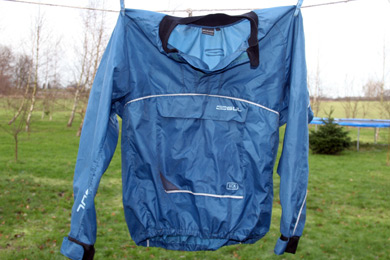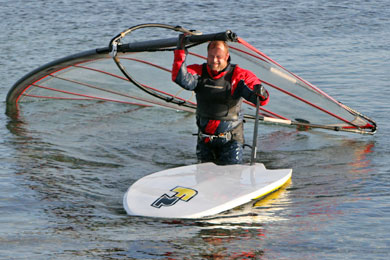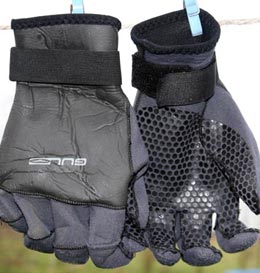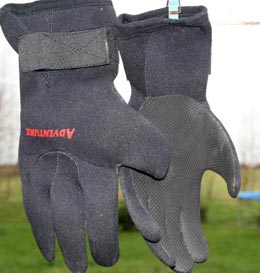| Clothing. | ||
|
The most urgent problem with cold during winter windsurfing, the fingers and hands, is closely related to the well being of the body and the head. If your body and your head are warm, you're seldom feeling cold in your limbs.
A good neoprene suit with 5 mm of thickness in the body area and a little less thickness in the arms and legs areas is the classic winter clothing. If you sail a lot with big equipment, or if you for other reasons don't get in contact with the water very often, it's not strictly necessary with a watertight zipper. For this reason (and because of the better fit and freedom of movement) it has been possible for me for the last few seasons to sail through the wintertime in a so called 3 season suit without watertight closure. But - if you're unlucky and you have to swim home with the equipment, of course you're exposed to a (potentially dangerous!) higher rate for intrusion and replacement of water.
A large part of the cold connected to windsurfing origins from the wind chill and the evaporation, and consequently a wind tight anorak (from nylon, polyester or the like) without a hood (worn beneath the life jacket and harness) is a fantastic supplement in cold days. The type the kayakers are using is very good. To invest in a Gore Tex jacket isn't worth it, as the garment doesn't function when coming in touch with salt water.
A very warm kind of suit is the kind of dry suit used by dinghy sailors in the wintertime, 100% watertight and made from several layers of fabric - worn over a kind of suit made from fleece or fiber pile. Many kiters use the suit in the wintertime, and in my place many winter windsurfers have jumped on the bandwagon too. The advantages are ...
However, there are some drawbacks too ...
Seen away from the fact that a cold head can be the start of a major headache, it's also pretty important to keep your head warm from other reasons. The head is poured through with a lot of blood, and if this blood is cooled down too much, of course it can have consequences for the well being for the rest of the body. The classic headgear for winter windsurfers is a neoprene band or a separate neoprene hood (that is a kind of balaclava). Covering your ears with neoprene can be an uneasy feeling - partly because the neoprene efficiently close out all sounds, partly because a neoprene hood with a tight fit have a tendency not to allow water to escape from your years after (for instance) a catapult. One solution is to make small holes on level with your years - or you can use a traditional knitted cap. If you choose the last option, a cap knitted from synthetic yarn is best, as a cap knitted from wool enlarges when getting wet. To avoid the cap to disappear every time you (involuntary) jump into the water, it's probably necessary with a kind of string or webbing to the suit.
A few years back, I remember cold feet being an issue. But now it's my impression that the softer and more neoprene like material in the new surf boots normally is an adequate protection against cold coming from beneath.
Even if a good suit and hood/cap is very important for the need to protect your hands, after all you probably have to take a closer look at the glove/mitten problem - the most discussed issue among winter windsurfers.
Some fight the cold with ordinary washing-up gloves. Of course these very thin gloves hinder the cold water to get in direct contact with your fingers, and at the same time the cooling affect from the evaporation from the gloves isn't as big as the cooling effect from evaporation from the skin of your hands. With the very thin glove material you don't get cramps in your fingers, your hands or your forearms. However, when it's really cold the washing-up gloves isn't nearly enough to isolate against the cold.
With the classical surf mittens with open palm you avoid the cramps coming from the thickness of the material of the ordinary closed mitten. With the bare skin in your palms you get a good grip to the boom - but the negative effect is that the open palm allows very quick replacement of water, if you get in contact with the wet stuff.
You might be lucky to get hold of at pair of closed neoprene mittens (from Da Kine) with a thin material in the palm (much thinner than neoprene) that is tough and have a good grip. This could be the best solution to cold fingers, and the only problem might be the restricted motor function coming from the "locked together" fingers.
The neoprene gloves are avoided by many windsurfers because of the thickness of the material in the palms and inner side of the finger area. If the neoprene in the palms furthermore has a kind of hard-wearing coating, the result often is a very bad grip in the boom, that can result in cramps. The advantage with the neoprene gloves is the better freedom of movement, coming from separated fingers - for instance making it easier to operate the outhaul trim. Perhaps a bit strange I must admit that I prefer the gloves. If you should be a little tired in your fingers and forearms from this type of finger protection, it's only a sign that you haven't been very much on the water lately - and then you know what to do about it (exercise!). |
||
|
|
A very good 3 season suit that is plenty warm enough to use through the winter - at least if it is combined with an synthetic, wind tight anorak (kayak type, see below).
The owner has obviously chosen the knitted cap over the neoprene hood. As you see, it's fastened in the webbing of the zipper by means of a push-in buckle ("Fastex").
(The tassel of the cap is a relic from the festival of the winter-time). |
|
 |
A wind and water tight anorak of the type used by kayakers.
The anorak is a very efficient weapon against the cold coming from wind chill and evaporation (yes, even in winter temperatures) from the surface of the neoprene suit. |
|
 |
A dry suit of hard wearing multi layer fabric, worn over a body stocking from fiber pile or fleece. The suit is very warm - yes it's often so warm that you can leave hood/cap and mittens/gloves on shore . Users appreciate that they can arrive to the surf spot partly dressed - that is in the body stocking (not recommended for shopping on the way).
Problem: The suit hasn't got the same buoyancy as a neoprene suit - and wearing the dry suit it can be a little difficult to swim up your equipment after a catapult. |
|

A pair of Gul gloves with pre-bend fingers. The gloves are warm and pretty durable - and they are good to work with.
Problem: The coating in the palms is so slippery that you get cramps in the attempt to get a grip. If you make the coating more rough by sanding it and/or often clean the cover of the boom, the problem diminishes a little. |

A pair of Da Kine mittens. As the the fingers aren't separated, they can to some degree give warmth to each other. The thin, rough material in the palms give very good grip around the boom tubes.
Problem: Mittens generally don't allow detail work with your fingers. For instance the outhaul trim and other adjustments are easier done with gloves. |

A pair of cheap (13 Euro) neoprene gloves from a super market with slightly pre-bend fingers (some have slit-fingers for fishing). The gloves are fairly thick and warm, and the neoprene material in the palms give good friction against the boom.
Problem: Some might dislike that the thickness of the material in the palms trigger off cramping - and the soft palm material isn't that durable. |
